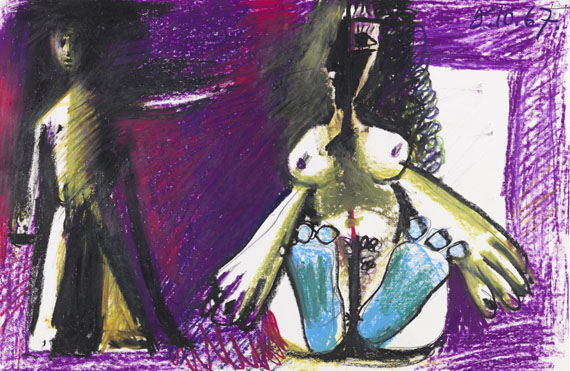Dictionary


Analytic cubism
The period that followed early Cubism is generally referred to as Analytic Cubism, it had its heyday between 1910 and 1912. As the term implies, the analysis of the object is in the center of Analytic Cubism, the exploring fragmentation of the object is in the foreground.
Analytic Cubism is based on the rejection of a fixed point of perspective and, accordingly, the principle of simultaneousness. Numerous views of the object are simultaneously depicted, whereas the facetted individual forms are put in numerous rhythmic relationships with one another and their surroundings. The form finally lost its clear outline and volume, it was reconstructed from its mutually penetrating single views. The focus on the form also had the usage of tondo- or oval formats as a consequence, which could reduce the background area. Another consequence was a clear reduction of the coloring, which was now limited to fractured tones (brown, gray, shades of blue) in combination with white or black lines with the purpose of a partial restriction. The flow in Analytic Cubism seems open and picturesque, in terms of motifs, objects of utility were often depicted.
Pablo Picasso's "Bildnis des Kunsthändlers Ambroise Vollard" (Portrait of the Art Dealer Ambrose Voillard, 1910) or Georges Braque's "Krug und Violine" (Jug and Violin, 1910) are exemplary works of Analytic Cubism. Besides these two painters, Juan Gris and Fernand Léger also began to experiment with forms in the sense of Analytic Cubism.
In a period within Analytic Cubism that is often referred to as "Hermetic Cubism", the style approached total abstraction, however, it rediscovered the object around 1912, which was now increased by a focus of materiality. The first material collages were executed in this context, for instance Picasso's "Stillleben mit Rohrstuhlgeflecht", (Still Life with Cane Chair Meshwork, 1912), which was, along with the preparation of abstraction, one of the most groundbreaking innovations of Cubism.
The period that followed early Cubism is generally referred to as Analytic Cubism, it had its heyday between 1910 and 1912. As the term implies, the analysis of the object is in the center of Analytic Cubism, the exploring fragmentation of the object is in the foreground.
Analytic Cubism is based on the rejection of a fixed point of perspective and, accordingly, the principle of simultaneousness. Numerous views of the object are simultaneously depicted, whereas the facetted individual forms are put in numerous rhythmic relationships with one another and their surroundings. The form finally lost its clear outline and volume, it was reconstructed from its mutually penetrating single views. The focus on the form also had the usage of tondo- or oval formats as a consequence, which could reduce the background area. Another consequence was a clear reduction of the coloring, which was now limited to fractured tones (brown, gray, shades of blue) in combination with white or black lines with the purpose of a partial restriction. The flow in Analytic Cubism seems open and picturesque, in terms of motifs, objects of utility were often depicted.
Pablo Picasso's "Bildnis des Kunsthändlers Ambroise Vollard" (Portrait of the Art Dealer Ambrose Voillard, 1910) or Georges Braque's "Krug und Violine" (Jug and Violin, 1910) are exemplary works of Analytic Cubism. Besides these two painters, Juan Gris and Fernand Léger also began to experiment with forms in the sense of Analytic Cubism.
In a period within Analytic Cubism that is often referred to as "Hermetic Cubism", the style approached total abstraction, however, it rediscovered the object around 1912, which was now increased by a focus of materiality. The first material collages were executed in this context, for instance Picasso's "Stillleben mit Rohrstuhlgeflecht", (Still Life with Cane Chair Meshwork, 1912), which was, along with the preparation of abstraction, one of the most groundbreaking innovations of Cubism.
Offers
Headquarters
Joseph-Wild-Str. 18
81829 Munich
Phone: +49 89 55 244-0
Fax: +49 89 55 244-177
info@kettererkunst.de
Louisa von Saucken / Undine Schleifer
Holstenwall 5
20355 Hamburg
Phone: +49 40 37 49 61-0
Fax: +49 40 37 49 61-66
infohamburg@kettererkunst.de
Dr. Simone Wiechers / Nane Schlage
Fasanenstr. 70
10719 Berlin
Phone: +49 30 88 67 53-63
Fax: +49 30 88 67 56-43
infoberlin@kettererkunst.de
Cordula Lichtenberg
Gertrudenstraße 24-28
50667 Cologne
Phone: +49 221 510 908-15
infokoeln@kettererkunst.de
Hessen
Rhineland-Palatinate
Miriam Heß
Phone: +49 62 21 58 80-038
Fax: +49 62 21 58 80-595
infoheidelberg@kettererkunst.de
We will inform you in time.




